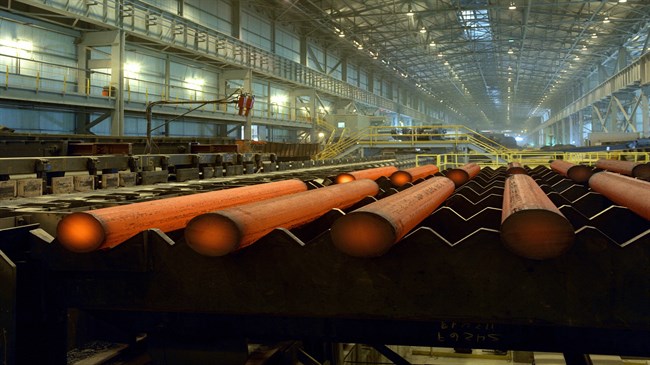
Investments Needed to Achieve Steel Targets Insufficient

Iran has attracted about 53.5% of the $3.65 billion of investment required for realizing its crude steel capacity expansion goals by 2025.
The country aims to become the world’s sixth largest steel producer as per the 20-Year Vision Plan (2005-25), which envisions achieving the annual crude steel production capacity of 55 million tons per year.
According to Minister of Industries, Mining and Trade Mohammad Reza Nematzadeh, Iranian steel mills have so far materialized 31 million tons of the capacity expansion target.
Reaching the 55 million-ton target requires boosting production capacity for direct-reduced iron by 116.3% to 53 million tons, pellets by 150% to 80 million tons and iron ore by about 100% to 87 million tons.
According to Fooladnews, capacity expansion for sponge iron, iron ore and pellet production needs investments worth $2.4 billion, $1.87 billion and $1.34 billion, of which 52.5%, 30% and almost 100% have been attracted.
In fact, deputy minister of industries, mining and trade, Mehdi Karbasian who is also the head of Iranian Mines and Mining Industries Development and Renovation Organization, has said $50 billion in foreign investment are required for the development of Iran’s mining sector.
“About $30 billion of the figure will need to be invested in the steel industry and its downstream sectors and the rest in copper, aluminum and other industries,” he was quoted as saying on the sidelines of the Second Iran Mines and Mining Industries Summit held in December.
 Iranian steel mills produced 17.89 million tons of crude steel in 2016, registering a 10.8% growth compared with the previous year.
Iranian steel mills produced 17.89 million tons of crude steel in 2016, registering a 10.8% growth compared with the previous year.
Post-Sanctions Scenario
The Iranian steel industry had a convincing performance in 2016 despite all the headwinds on the local and global level, mainly thanks to the removal of nuclear sanctions, which provided Iranian steelmakers with much-needed new export destinations amid a glut in the local market.
Sanctions began to roll back in January 2016 as part of a deal signed between Iran and world powers the year before. In exchange, Iran agreed to limit the scope of its nuclear program.
Iranian steel mills produced 17.89 million tons of crude steel in 2016, registering a 10.8% growth compared with the previous year, according to World Steel Association.
Iran maintained its position as the world’s 14th biggest steelmaker as its 2016 output placed it between Mexico (13th) with 19 million tons and France with 14.63 million tons of crude steel output.
Iran’s steel sector was the sixth fastest growing in the world last year after Serbia with 22.7%, Pakistan with 22.8, Greece with 31.8%, Libya with 39.8% and Macedonia with 62.2%.
Latest data show Iran’s major steelmakers exported over 4.12 million tons of crude steel and steel products in the nine months to December 20, registering a 55% growth compared with last year’s corresponding period, according to Iranian Mines and Mining Industries Development and Renovation Organization.
Rasoul Khalifeh-Soltani, the head of Iran Steel Producers Association, said exports are expected to reach 5.7 million tons by the end of the current fiscal year (March 2017).
According to the official, the recovery of global steel prices have driven steel producers to increasingly shift their attention to exports.


Trump weighs using $2 billion in CHIPS Act funding for critical minerals

Codelco cuts 2025 copper forecast after El Teniente mine collapse

Electra converts debt, launches $30M raise to jumpstart stalled cobalt refinery

Barrick’s Reko Diq in line for $410M ADB backing

Abcourt readies Sleeping Giant mill to pour first gold since 2014

Nevada army depot to serve as base for first US strategic minerals stockpile

SQM boosts lithium supply plans as prices flick higher

Viridis unveils 200Mt initial reserve for Brazil rare earth project

Tailings could meet much of US critical mineral demand – study

Kyrgyzstan kicks off underground gold mining at Kumtor

Kyrgyzstan kicks off underground gold mining at Kumtor

KoBold Metals granted lithium exploration rights in Congo

Freeport Indonesia to wrap up Gresik plant repairs by early September

Energy Fuels soars on Vulcan Elements partnership

Northern Dynasty sticks to proposal in battle to lift Pebble mine veto

Giustra-backed mining firm teams up with informal miners in Colombia

Critical Metals signs agreement to supply rare earth to US government-funded facility

China extends rare earth controls to imported material

Galan Lithium proceeds with $13M financing for Argentina project

Kyrgyzstan kicks off underground gold mining at Kumtor

Freeport Indonesia to wrap up Gresik plant repairs by early September

Energy Fuels soars on Vulcan Elements partnership

Northern Dynasty sticks to proposal in battle to lift Pebble mine veto

Giustra-backed mining firm teams up with informal miners in Colombia

Critical Metals signs agreement to supply rare earth to US government-funded facility

China extends rare earth controls to imported material

Galan Lithium proceeds with $13M financing for Argentina project

Silver price touches $39 as market weighs rate cut outlook

















